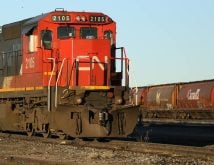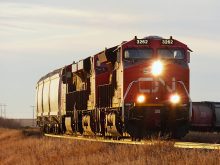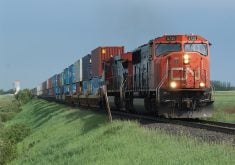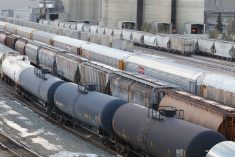OTTAWA (Reuters) — Canada is facing unprecedented simultaneous stoppages at both of its main freight rail operators, which could inflict billions of dollars worth of economic damage.
The two rail operators, Canadian National Railway and Canadian Pacific Kansas City, are holding separate talks with the Teamsters’ union, which represents about 10,000 workers across locomotive engineers, conductors, train and yard workers and rail traffic controllers.
Related stories:
- Freight stoppage looms as railways issue lockout notices
- Why Canada is on the verge of an unprecedented rail labour stoppage
- CPKC expands freight embargoes
The talks are currently deadlocked and the rail companies say they will start locking out workers Aug. 22 if they do not reach a labour deal.
Read Also

Government, industry seek canola tariff resolution
Governments and industry continue to discuss how best to deal with Chinese tariffs on Canadian agricultural products, particularly canola.
Here are a few key facts about the two rail operators:
Historical background
CN’s history dates back to the 1830s, but it was only officially incorporated in 1919. Headquartered in Montreal, the company was government-owned until it was taken public in 1995. Through its acquisitions of Illinois Central Corp. and Wisconsin Central in the late 1990s and early 2000s, CN expanded its rail network across the Great Lakes region and down to the Gulf of Mexico.
CPKC’s history dates back to the 1880s. Previously known as Canadian Pacific Railway, it was built to connect Canada from coast to coast. CP was once involved in several businesses including mining and hospitality, and it built and owned iconic Canadian properties such as the Banff Springs Hotel, the Royal York in Toronto and Château Frontenac in Quebec City.
Calgary-headquartered CP spun out its other businesses in 2001. It bought Kansas City Southern Railway in 2021, and it became CPKC, forming the first single-line rail connecting the United States, Mexico and Canada.
Rail networks
Although some U.S. rail operators do have small branch lines that enter Canada, CN and CPKC hold a duopoly and are the two dominant freight rail operators in the country. With coast-to-coast networks, the duo account for the vast majority of all rail transport industry revenues in the country, own more than 75 per cent of all tracks and account for roughly three-quarters of the overall tonnage carried by the rail sector in Canada.
For Canada, the two operators serve as important supply chain links to trade corridors and ports across the continent.
CN, which employs around 25,000 people, has a network that stretches from Vancouver to Halifax in Canada and all the way down to New Orleans.
CPKC, which has roughly 20,000 employees, has a network that runs from Vancouver to Montreal. It also links to the ports of Corpus Christi, New Orleans and Gulfport on the Gulf of Mexico, and further south it connects to the ports of Tampico and Lázaro Cárdenas on the east and west coasts of Mexico.
Revenue mix
In 2023, 25 per cent of CN’s freight revenue came from grain, fertilizer and coal, while metals, minerals and forest products were 24 per cent of its revenue mix and petroleum products, chemicals, autos and intermodal container cargoes accounted for the remainder.
In 2023, 35 per cent of CPKC’s freight revenue came from shipments of coal, grain, potash and fertilizers. Forest products, energy, chemicals, metals and autos accounted for 45 per cent of its revenue mix, with the remainder coming from intermodal container cargo.
Previous work stoppages
In 2019, about 3,200 unionized workers of CN, including conductors and yardmen, went on an eight-day strike in Canada. It led to heating fuel shortages, large backlogs and a slowdown in industrial output from plants making goods ranging from chemicals to canola oil.
In 2018, a day-long strike ended after the Teamsters and CP reached a four-year contract. And in 2015, CP and the Teamsters agreed to seek mediated arbitration, ending another short-lived strike.
In 2012, about 4,800 locomotive engineers, conductors and yardmen of CP went on over a week-long strike that ended only after the government introduced back-to-work legislation, at a time when the economy was still recovering from the global financial crisis and a recession.

















